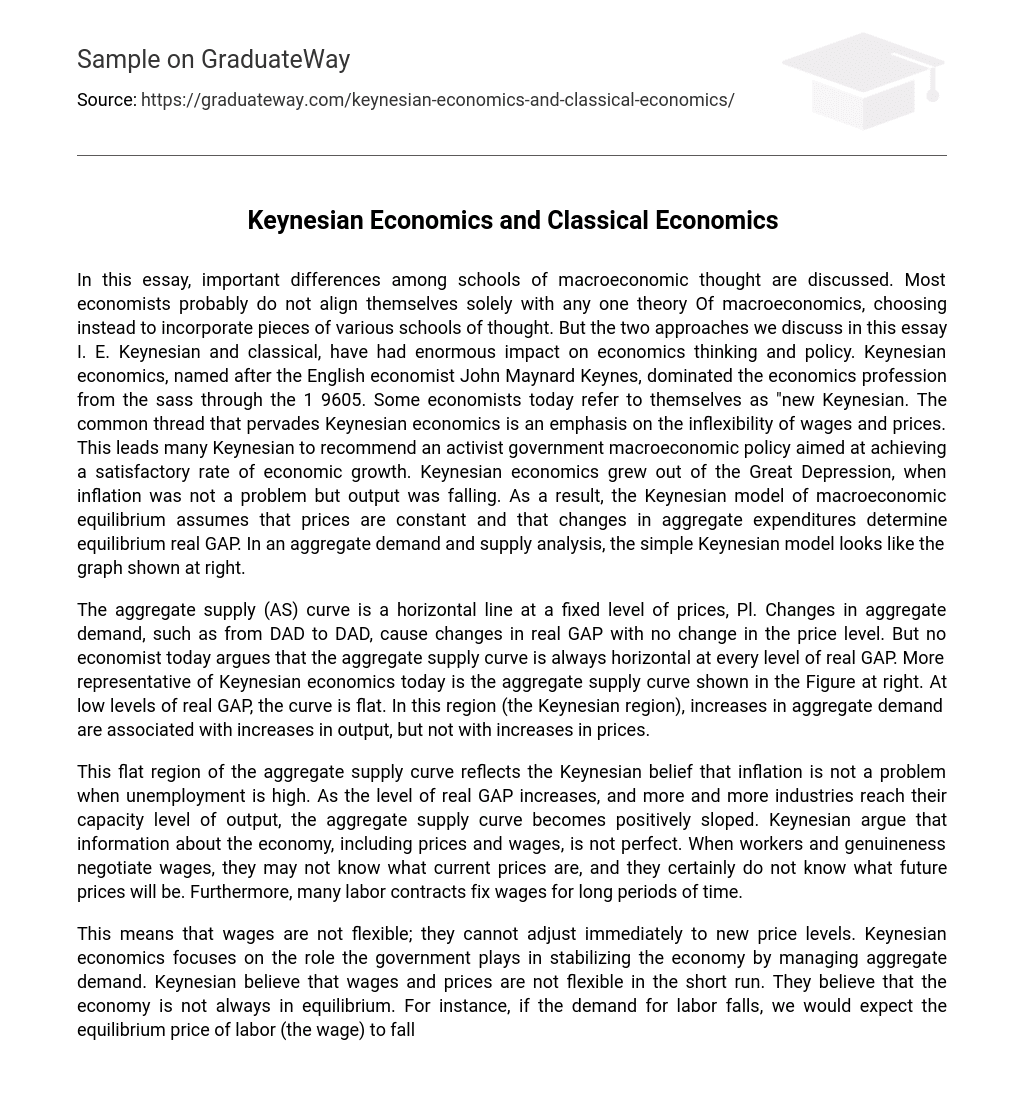The essay examines the distinctions in macroeconomic thought between various schools, specifically focusing on Keynesian and classical perspectives. While economists often incorporate elements from multiple theories, these two approaches have had a significant impact on economic thinking and policy. Named after John Maynard Keynes, Keynesian economics dominated the field from the 1930s to the 1960s and continues to be influential today, with some economists identifying as “new Keynesians.” The central tenet of this approach is a belief in wage and price rigidity, leading many Keynesians to advocate for active government macroeconomic policy in order to achieve satisfactory economic growth. This theory emerged during the Great Depression when output was declining but inflation was not a concern. Consequently, according to the Keynesian model, prices remain stable while changes in aggregate expenditures determine equilibrium real GDP. The accompanying graph illustrates a basic Keynesian model within an analysis of aggregate demand and supply.
The AS curve is a horizontal line at a fixed price level, Pl. Changes in aggregate demand, from DAD to DAD, result in changes in real GAP without altering the price level. However, modern economists do not support the belief that the aggregate supply curve is always horizontal regardless of real GAP level. The Figure on the right depicts an aggregate supply curve that is more indicative of current Keynesian economics. In the Keynesian region, which represents low levels of real GAP, the curve is flat. In this region, an increase in aggregate demand leads to an increase in output but does not cause prices to rise.
This section of the aggregate supply curve reflects the perspective of Keynesian economists who believe that high unemployment does not cause inflation. As real GDP rises and industries reach their maximum production levels, the aggregate supply curve becomes upward sloping. Keynesians argue that there is limited understanding about economic factors such as prices and wages. This lack of information during wage negotiations can lead to workers and companies being unaware of present and future price changes. Additionally, numerous labor contracts specify fixed wages for prolonged periods.
Keynesian economics posits that wages and prices are rigid in the short term and cannot promptly adjust to new price levels. Consequently, the government assumes a crucial role in stabilizing the economy by overseeing overall demand. Advocates of Keynesianism contend that the economy is not consistently in balance. For instance, if labor demand declines, the equilibrium wage (the cost of labor) ought to decrease as well. This would consequently reduce individuals’ willingness to work for a lower wage, ultimately leading to decreased employment.
According to Keynesians, the government should intervene actively in order to restore economic equilibrium. They argue that firms choose to lay off workers instead of decreasing wages because they believe that maintaining high wages for remaining employees is crucial for morale and productivity. As a result, wages become inflexible. This rigidity is also evident in the inflexibility of prices in goods markets according to Keynesian economics. Before Keynes revolutionized the field of economics in the 20th century, classical economics was the dominant theory.
Classical economics states that real GAP is influenced by aggregate supply, while the equilibrium price level is influenced by aggregate demand. The classical aggregate demand and supply diagram on the right represents the classical economist’s perception of the global economy. The vertical aggregate supply curve implies that the equilibrium level of output (income) is solely determined by the factors affecting aggregate supply, and that the economy typically operates at full employment.
When the aggregate supply curve is vertical, changes in aggregate demand, from DAD to DAD, solely impact the price level without influencing the equilibrium output. Classical economics presumes perfect flexibility in prices and wages to ensure quick market clearing. This excludes fixed-price or fixed-wage contracts and assumes that individuals are aware of all price changes and respond by requesting wage increases as compensation.
Classical economists argue that during a recession, people tend to engage in non-labor activities more often. These activities may include returning to school, retiring early, working remotely, or simply enjoying leisure time. The reason for this behavior is that real wages are lower during economic downturns. However, as the economy recovers and wages increase, individuals gradually replace their non-labor activities with more working hours. This ongoing substitution between labor and leisure suggests that a significant portion of unemployment is voluntary. In other words, unemployed individuals choose not to accept job offers if the wages offered are below their reservation wage or due to external factors influencing their decision.
Classical economics is based on the idea of a free-market, with minimal government intervention. This enables individuals to make economic decisions in their own self-interest, ensuring resources are allocated according to market participants’ preferences. Supporters of classical economics argue that the economy can consistently maintain and reach its natural level of real GDP. Although occasional factors may impact the economy and lead to deviations from this level, supporters believe that automatic adjustment mechanisms exist.





